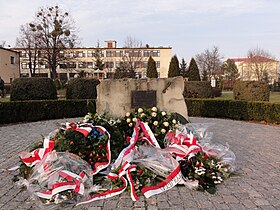Cichociemny
|
Cichociemni The Silent Unseen |
|
|---|---|

Monument to the Silent Unseen in Dębowiec
|
|
| Active | 16 February 1941 – 27 December 1944 |
| Country | occupied Poland |
| Allegiance | Polish government-in-exile |
| Type | Special operations paratroops |
| Role | Armed forces of Polish Underground State/Polish government-in-exile |
| Engagements | World War II Operation Tempest, Operation Ostra Brama, Lwów Uprising and Warsaw Uprising |
Cichociemni (Polish pronunciation: [t͡ɕixɔˈt͡ɕɛmɲi]; the "Silent Unseen") were elite special-operations paratroops of the Polish Army in exile, created in Great Britain during World War II to operate in occupied Poland (Cichociemni Spadochroniarze Armii Krajowej).
Altogether 2,613 Polish Army soldiers volunteered for training by Polish and British SOE operatives. Only 606 people completed the training, and eventually 316 of them were secretly parachuted into occupied Poland. The first operation ("air bridge", as it was called) took place on 15 February 1941. After 27 December 1944 further operations were discontinued, as by then most of Poland had been occupied by the Red Army.
Of 316 Cichociemni, 103 perished during the war: in combat with the Germans, executed by the Gestapo, or in crashes. A further nine were executed after the war by the Polish People's Republic. Altogether 91 operatives took part in the Warsaw Uprising of 1944.
The origins of the name are obscure and may never be known with certainty. "Silent Unseen" probably related to how some soldiers seemingly disappeared from their line units overnight to volunteer for special operations service, and also describes those "who appear silently where they are least expected, play havoc with the enemy and disappear whence they came, unnoticed, unseen."
The Silent Unseen were trained initially in Scotland in preparation for missions for the Polish underground in occupied Poland, such as building-clearance and bridge-demolition. In 1944, training was also carried out in Brindisi, Italy, which had by then fallen to the Allies.
Initially the name was informal and was used mainly by soldiers who volunteered to parachute into Poland. However, from September 1941 the name became official and was used in all documents. It was applied both to the secret Polish Headquarters training unit created to provide agents with necessary knowledge, money and equipment, as well as to agents who were transported to Poland and other German-occupied countries.
...
Wikipedia
